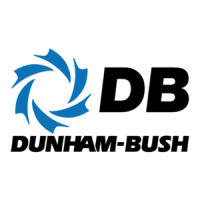
Do you have a question about the Dunham-Bush R22 WCPS-B Series and is the answer not in the manual?
| Brand | Dunham-Bush |
|---|---|
| Model | R22 WCPS-B Series |
| Category | Air Conditioner |
| Language | English |
Explains the model naming convention for the units.
Details procedures for receiving and inspecting the unit upon delivery.
Provides guidelines and precautions for handling and unpacking the unit.
Lists operational restrictions and conditions to avoid for optimal performance.
Describes requirements and methods for unit foundation and placement.
Recommends optimal placement for units to facilitate operation and reduce costs.
Specifies minimum clearances required around the unit for access and airflow.
Instructions for safely removing packaging and preparing the unit for installation.
Information regarding the unit's blower system, discharge patterns, and duct connections.
Details about the unit's evaporator section, including coil depth and filter access.
Information on the condenser section, including pressure ratings and connections.
Recommendations for selecting and installing cooling towers for condenser water.
Discusses factors influencing unit capacity and control methods.
Explains the importance of correct water flow rates for condenser performance.
Details thermostat placement and environmental considerations for accurate control.
Specifies recommended temperature settings for cooling and heating modes.
Addresses potential issues with compressor rotation during initial startup.
Advises on compressor cycling limits to ensure longevity and performance.
Explains the function and adjustment of the hot gas bypass valve.
Illustrates and lists the key components of the unit's refrigerant system.
Provides a visual flow chart of the unit's standard operating sequence.
A comprehensive checklist for verifying proper unit installation and readiness.
Electrical wiring diagram for units without a starter.
Electrical wiring diagram for units using Direct On-Line starters.
Electrical wiring diagram for units utilizing auto-transformer starters.
General advice on the importance of regular inspection and preventive maintenance.
Outlines a recommended schedule for unit inspection and maintenance tasks.
Focuses on maintaining the unit's condenser heat transfer surfaces for efficiency.
Discusses common water treatment problems and suggested controlling chemicals.
Provides torque specifications for tightening pulley set screws.
Step-by-step instructions for aligning unit pulleys using a string method.
Guide on how to measure and inspect belt tension using a tension meter.
A diagnostic chart to identify causes and remedies for common unit faults.
A template for recording periodic operational data for monitoring and troubleshooting.